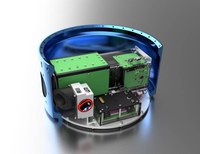ESAT-SHI

Spatial Heterodyne Interferometer (SHI) placed on small satellite instruments is one technique for temperature measurement in the upper atmosphere to provide scientific data for climate models and gravity wave characterization. We develop fault-tolerant sensor electronics using special methods to enable the use of highly integrated processor architectures based on commercial off-the-shelf components (COTS) for long-term small satellite missions.
For all science missions, customized payload electronics have to be developed, depending on measurement tasks and requirements. Especially for the deployment of more complex remote sensing payloads, state-of-the-art performance is needed to provide operational control and specific data processing of the image sensors.

A key to addressing these challenges is the use of advanced embedded Multi-Processor System-on-Chips (MPSoC). These combine different types of processors on a single chip and enable increased system reliability through tailored redundancy concepts.
With a highly integrated System on Module (SoM) architecture high processing power capabilities are available with low resource requirements. The major advantages are flexibility, (re)programmability, modularity and module re-use in respect to lower development time and costs. However, it is a challenge to make this module suitable to implement it into space environment.
A radiation tolerant characteristics will be achieved by modelling the radiation environment, estimating the hazards at module level and reducing it to acceptable risks with necessary measures of mitigation techniques. This approach results into a sensor electronics which combines hardware and software redundancies to assure system availability and reliability for long life science missions in a Low-Earth-Orbit (LEO).

Our research and development work is currently focused on improving the reliability of measurement systems for use in small satellites. The developed concepts are validated both by simulations of radiation effects and by experience with scientific measuring instruments that have already been implemented.
Flight heritage and further missions

AtmoHIT
The AtmoHIT experiment was part of the Rocket Experiment for University Students campaign (REXUS 22), realized under a bilateral agency agreement between the German Aerospace Centre (DLR) and the Swedish National Space Board (SNSB). The AtmoHIT experiment was launched on 26th of March 2017 at 12:58 UTC. The rocket reached its ceiling altitude of 84.3 km 140 s after launch.

AtmoSHINE
On 22-12-2018 at 0:51 CET, a rocket of type “Long March 11” launched from the Chinese Jiuquan spaceport into a sun-synchronous orbit. At an altitude of 1100 km, AtmoSHINE orbits the earth along the day-night boundary on board a technology demonstration satellite. The successful project is an important milestone on the way to developing a CubeSat constellation to study the dynamics of the atmosphere.

AtmoLITE
Within AtmoLITE a new generation of science sensor electronics was integrated in a 27U micro-satellite INSPIRESat-4, as part of the Atmospheric Coupling and Dynamics Explorer (ARCADE) mission, which is the fourth satellite in the International Satellite Program in Research & Education (INSPIRE) series.AtmoLITE was succesfully launched on July 30, 2023 at 01:01 UTC and a further instrument deployment is planned onboard the INSPIRE-3a satellite in 2026.

AtmoSHIPAS
AtmoSHIPAS is the first generation with two camera systems that, in addition to horizon sounding, also measures stray light and is equipped with multi-channel imaging electronics for this purpose. This instrument is to be deployed on the latest generation of the P200 satellite platform from Redwire Space (formerly QinetiQ Space) as part of the EU initiative “Horizon 2020 In-Orbit Demonstration and Validation (IOD/IOV)” for validation in orbit.
Contact
- Institute of Technology and Engineering (ITE)
Room 220

